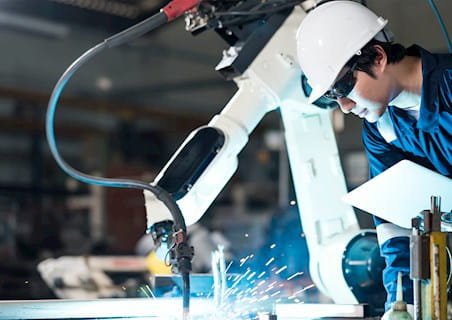Episode 18: The Digital Economy: Is a Recession Really Coming?
Dana M. Peterson, Chief Economist at The Conference Board
Q&A
Can you share more information about The Conference Board and the work you do there?
The Conference Board is a 107-year-old business think tank focused on delivering insights for what's ahead. Our clients are C-suite executives of Fortune 500 companies from around the world. We provide insights that include economics, ESG, human capital, marketing and communications, and public policy and geopolitics.
As recessionary concerns rise, we're seeing layoffs in a lot of industries, particularly in the tech sector. Can you tell us about the findings from the Employment Trends Index published by The Conference Board–and what you’re anticipating around hiring and growth through 2023?
Absolutely. I think the labor market is divided into three segments:
-
Segments that are letting people go. These include information, technology, transportation and warehousing, retail, construction and real estate. Those industries did very well during the pandemic when everyone was cooped up and interest rates were low. Now that interest rates have risen and there's less demand for technology and goods, those segments are rightsizing, and letting people go.
-
Segments that have labor shortages and are hiring. Some of those sectors include hotels, restaurants, healthcare, and even the government sector–usually industries where you have to physically show up to work. These industries are hiring more people and increasing their payrolls every month.
-
Somewhere in the middle. The industries in this sector are more stagnant–no layoffs, no hiring.
It's these end-point sectors that are driving the labor market. We believe as we progress through the year, the sectors that are letting people go will overwhelm the sectors that are adding jobs. So we do expect the unemployment rate to rise and payrolls to start turning negative later in the year. But the unemployment rate is probably not going to rise by that much (maybe one percentage point) so going from roughly 3.5% right now to 4.5%. That's still a tight labor market compared to previous downturns: at the start of the pandemic, the unemployment rate shot up to 13.5%, and during the Great Recession, the unemployment rate was 10%.
Generative AI, including ChatGPT, is having a moment. From your perspective, how will AI impact the workforce?
Generative AI is both creative and additive, as well as destructive and subtractive. AI can be used to save time–for instance, think of how much time economists spend researching and writing reports. It might be useful to put a few code words into AI to get a general direction. However, it’s important to note that AI is only pulling existing materials, so it still needs a human element. Jobs will be created because of AI but jobs will also certainly be eliminated.
In your article discussing U.S. CEOs and their preparation for a brief and shallow recession, you shared that of the CEOs surveyed, 93% are preparing for recession. What are you seeing CEOs do to prepare?
There are a couple important things:
- Most CEOs are thinking about what to do with their labor forces and sales. An interesting thing to note is that they’re either looking to hire more people or keep their current workers rather than letting them go. There’s another issue to consider here as well: labor shortages. Even though labor shortages might lighten up a bit over the next few quarters, they are a long-term problem because all the baby boomers are retiring. Companies are trying to keep people on board because there’s not enough younger people to hire, and baby boomers certainly have a lot of experience that the younger generation just doesn’t have yet.
- Another thing businesses are actively doing is increasing liquidity–making sure they have cash on hand, which is related to the banking crisis. However, even before the banking crisis, they were looking at liquidity issues, especially since the Fed is raising interest rates and making it much more expensive to go to financial institutions for cash.
We've been talking about recession concerns since last summer/fall. Is the recession here? If so, what are the implications?
We have three measures we consider when thinking about a recession: CEO Confidence Survey, Consumer Confidence Gauge, and Economic Indicators Gauge. All our gauges are saying the recession should be starting right about now. And really the key is the consumer. If consumers feel like something is going on, if something is bad, if they might lose their jobs, then they're going to pull back on consumption. And we have seen some pulling back on consumption in two areas:
- Consumers have stopped buying houses because of high mortgage rates, and with that comes lack of spend on things like large appliances
- Consumers have pulled back on buying big ticket items that you need to finance like furniture and cars
The last piece of the puzzle for a consumer-driven recession to occur is consumers pulling back on services–and based on the last few readings of retail sales and personal consumption expenditure data, consumers are certainly pulling back.
Another consideration is that some businesses have already pulled back on investments in a lot of areas and will probably continue to do so, not only in terms of human capital but also equipment and structures.
As for the implications, we think that this recession will probably hurt a bit in terms of weakening the labor market and consumers pulling back on consumption. But it's not going to be anything like we've seen in the past two recessions, we expect it to be a bit more regular (high inflation, raising interest rates).
You authored an article titled The Silicon Valley Bank Collapse and Implications for Business. Could you dive into your findings and insights into how the downfall of SVB has affected businesses in the financial, technology and private equity sectors?
One of the biggest effects of the SVB failure is tighter financial conditions. Many banks, especially smaller ones, are having to go to the Fed to borrow cash and remain liquid, and because they're borrowing from the Fed, they're less likely to issue credit or lend cash to businesses and consumers, which is why I think this will affect businesses more than consumers.
Consumers are already pulling back on big spends. But when it comes to businesses, they are going to go to these banks and ask for capital for short-term purposes, for operating costs, but also for big investments. And if they are not given the cash because the banks have borrowed their money from the Fed, businesses will have to pull back on their plans for long-term investments.
When it comes to the tech sector and venture capitalism, this is a huge blow, because Silicon Valley Bank and other institutions that modeled their business practices like them had access to bespoke types of capital and lending, which is wiped out now. So now businesses and tech firms are going to have to go to angel investors or larger banks who are less likely to lend to startups, which certainly will pose a setback.
Another aspect we should touch on is rising geopolitical tensions and the implications for supply chains. Could you talk more about that and if there are any steps that businesses are taking to navigate challenges?
Governments are instituting something called industrial policies where, essentially, they tell businesses where they can situate their supply chains and their factories, pressuring business all around. We asked multiple domestic and global companies in a survey back in November how things might've changed since these policies came out and what they’re doing about their supply chains. In the U.S., the most common answer, 44%, said nothing. However, some other answers included thoughts like reshoring or creating redundancies.
But businesses also need to think about geopolitics and policies when thinking about moving their supply chains to other countries and keeping an eye on the cost. Overall, businesses are being squeezed by geopolitics, the pandemic's shock, and the realities of trade issues.
We asked executives what they are prioritizing to defend against external and existential issues, and some of the top responses were innovation, digital transformation, and automation.
”
What does “digital” mean to you?
Well, digital is anything that requires technology, right? So, semiconductor chips and STEM research and anything that you need more than just human capacity for. You need that aid of technology to make things greater and more efficient and more productive, but you can’t lose the human element.
Are there any important takeaways or any final thoughts that you'd like to leave our listeners with?
By the end of this year, inflation is probably going to be around 3% instead of 5%. So that's going to be good news. Looking further ahead, by the time we get to next year, inflation will go down to 2% because of the work that the Fed is doing.
Additionally, like I said, the recession is probably going to be short and shallow. So, that means not too many layoffs, most people will still be working, and we'll likely be out of it next year and see faster growth.
Related Content
This is Digital
West Monroe's team of experts and guests pull back the curtain on how to build digital throughout an organization. Through real-world examples, you will learn how to spot digital transformation in real life, and how to make small decisions every day that make a big impact on growth.










